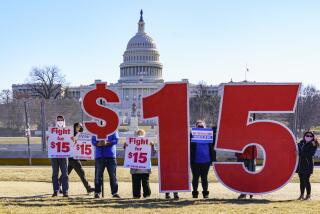Pay, Benefit Raises Averaged Only 2.9% in ’95
- Share via
Despite a growing economy that held down the unemployment rate and boosted the stock market throughout 1995, American workers received historic low pay and benefit increases averaging only 2.9% last year, the U.S. Labor Department reported Tuesday.
The narrow yearlong gain, which overshadowed an upward spurt in the last quarter of 1995, was down from 3% in 1994 and the smallest advance since the government began compiling its employment cost index in the early 1980s. Economists said it reflected what may have been the thinnest pay and benefit increases since before World War II.
What’s more, analysts said, the failure of workers to make more progress amid last year’s generally strong economy suggests that pay raises could shrivel further in 1996 if the slowdown evident in recent months persists.
The slow overall growth in wages and benefits, a major frustration for many voters, has been seized as a crucial domestic issue by politicians ranging from Republican presidential hopeful Patrick J. Buchanan to President Clinton. At the White House, Press Secretary Mike McCurry said that “wage stagnation” would be one of the major problems that will occupy Clinton “throughout this year and well into the second term.”
Unions, too, have emphasized the “wage stagnation” theme in both their political lobbying and recruiting drives.
Perhaps the best news for workers in Tuesday’s report was that wage and benefit increases last year outpaced the 2.5% rise in the consumer price index, the government’s main gauge of inflation. That gave workers, by the government’s estimates, a “real” compensation gain of 0.4%, up from 0.3% in 1994.
Still, economists consider the tiny after-inflation gains of the last several years almost insignificant. Taking inflation into account, “workers lost a lot of ground in the recession during ’90 and ‘91, and they’ve been treading water in the years since then. Now they’re set up to take another hit down the road” when the next recession arrives, said Dean Baker, an economist with the Economic Policy Institute, a labor-supported think tank.
Wayne M. Shelly, an economist with the U.S. Bureau of Labor Statistics, added: “The big question is when and if wages and salaries are going to pick up. They’ve been flat since 1992.”
Many analysts said the same host of factors that have spawned workers’ job insecurities in recent years--including the steady stream of layoffs by major companies, global competition and declining union clout--also are holding down wages. “It may be that workers are more concerned about keeping their jobs and keeping their benefits” than pushing for higher wages, Shelly said.
John Zalusky, economist for the AFL-CIO, asserted that “our standard of living is declining because we’ve chosen a low-wage, sweatshop mentality in terms of competing against the other nations of the world. We’re not investing in education and we’re not investing in our workers.”
On the other hand, Martin A. Regalia, chief economist for the U.S. Chamber of Commerce, largely blamed slow compensation increases on employers’ high costs for meeting regulatory requirements, covering payroll taxes and obtaining capital. He also noted that revised government figures show that recent productivity increases, which in past economic cycles corresponded with rising wages, have been smaller than previously believed.
Regalia, moreover, maintained that the nation’s labor market is softer than depicted by the government’s unemployment figures, which showed the jobless rate hovering from 5.4% to 5.8% through 1995.
All the same, Regalia shared the view of other economists that there is little reason to expect quick improvement in workers’ wages.
The employment cost index is the broadest measure yet available from the government on changes in compensation for all civilian workers in 1995. The component of the index that includes just wages and salaries also was up 2.9% last year, versus 2.8% in 1994. The section of the index covering employers’ costs for workers’ health care coverage and other employee benefits rose 2.8%, down from 3.4% in 1994.
Last year’s decline in benefit cost increases may have a positive side to the extent that it reflects health care cost containment rather than simply reduced coverage for workers.
Still, during the last three months of 1995, benefit costs leaped again, climbing 1.3%. In the third quarter, the gain was 0.4%. Analysts said the jump could signal anything from a statistical aberration to renewed inflation in the health care industry. If high inflation is resuming in the health care field, economists warned, that could put even more pressure on employers to hold down wages.
The figures show wages and salaries rising by 0.7% in each of the last three quarters. Overall, the employment cost index was up 0.9% in the fourth quarter, the biggest one-quarter increase in two years.
Still, economists said the employment cost figures for all of 1995 suggest that inflation overall remains under control. In fact, an economics assessment put out by Merrill Lynch & Co. on Tuesday predicted that there will be little pressure for increased wages this year, enabling inflation to remain “dormant” and encouraging the Federal Reserve Board to cut interest rates again soon.
While economists have expressed concerns about flat overall wage growth in the economy, many argue that it has been accompanied by a widening gap between the highest- and lowest-paid workers. Tuesday’s report gave further evidence of that gap, showing that compensation rose 3.1% in the white-collar occupations last year while increasing 2.6% in blue-collar occupations.
More to Read
Get the L.A. Times Politics newsletter
Deeply reported insights into legislation, politics and policy from Sacramento, Washington and beyond. In your inbox twice per week.
You may occasionally receive promotional content from the Los Angeles Times.










